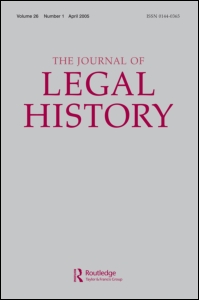(image source: university of Glasgow)
Family Law(s) under the Roman Empire (Yifat Monnickendam & Paul J. du Plessis)
The Limits of Legal Pluralism in the Roman Empire (Kimberley Czajkowski)
Abstract:
The Roman empire was legally pluralistic. But what exactly does this entail in concrete terms? With the growth in historical studies of legal pluralism in the Roman empire, some significant differences in approach have emerged. This article tests and clarifies some of the limits in the current ‘legal pluralism’ conceptual landscape, focussing on disputes and dispute resolution. It is argued that a clearer distinction should be drawn between ‘normative’ and ‘jurisdictional’ pluralism, though both approaches still raise certain conceptual problems. The place of disputes within the family within this wider institutional picture is then taken as a case study in the final part of the paper, and it is suggested that while family disputes can evidence ‘legal pluralism’ in the ‘norms’ sense, there is less to suggest that there were a multitude of officially sanctioned legal fora available for resolving family disputes. As a result, many went beyond the law. This has wider implications for the study of legal pluralism in antiquity and the problem of integrating alternative dispute resolution (ADR) into the pluralistic pictureGreek Influences on Roman Dowry Law (Michael Leese)
Abstract:
Classical and Hellenistic Greek laws and dowry practices were generally more progressive and provided more protections for wives than early Roman marriage law and practice. Roman dowry law then witnessed a series of significant developments over the course of the republic, beginning with the time when the Romans were coming into increased contact with Greek culture. Changes in social attitudes towards the conditions for women in marriage, their ability to control their dowries, and their right to own property, seem to have been responsible for these transformations in Roman family law. As Romans became increasingly Hellenized, their dowry and marriage practices in general came to resemble patterns prevailing in the Greek world, perhaps as a result of individuals’ emulation of Greek laws and customs. The shift from the overall predominance of marriage in manu to marriage sine manu may therefore be explained partly by influences from the Greek world.Herod the Great and the Iudicium Domesticum: Legal Pluralism to Die For (Thomas A. J. McGinn)
Abstract:
The central question under consideration in this article is whether the various trials to which Herod, the well-known king of Judaea, subjected family members qualify as instances of the Roman iudicium domesticum. Modern debate among legal historians has been shaped by the views of two scholars in particular, Wolfgang Kunkel, who argues that one of them so qualifies, and Alfredo Mordechai Rabello, who contends that the rest do not, asserting that Herod simply followed the rules and procedures associated with a Hellenistic court. For the first time in modern scholarship, this article scrutinizes in detail all six examples of such trials. By itself, the evidence, though relatively copious, does not permit us to resolve this dispute as clearly and unambiguously as we would like. Much depends, for example, on precisely how one wishes to define the institution in question. Recent scholarly advances in the area of legal pluralism, however, point in the direction of a solution that does justice to both sides of this debate, as well as, perhaps, to Herod himself.Did Roman Treatment of Freedwomen Influence Rabbinic Halakhah on the Status of Female Converts in Marriage? (Yael Wilfand)
Abstract:
Rabbinic legal texts often pair converts with freed slaves. This association has been explained by the notion that, like converts, freed slaves joined Judaism upon manumission; therefore, freed men and women were legally viewed like converts. I suggest an inverse and more complex dynamic, through which Roman laws and concepts regarding freed persons influenced particular elements of rabbinic halakhah concerning converts, especially female converts. Since Roman freedwomen were new citizens with certain marital limitations, which have been attributed to lacking pedigree and an assumed sexual history (during servitude), their legal status offered a useful prism for considering female converts, who also had matrimonial restrictions and were without lineage. Moreover, given that a freedwoman’s prior enslavement had implications for her sexual background, female converts were viewed through that same lens. So, even though female converts may have come from non-Jewish families that considered their daughters’ virginity an important asset, the rabbinic legal linkage of freed slaves and converts affected several halakhot concerning female converts and their status in marriage, irrespective of their actual sexual history. Yet certain non-legal rabbinic teachings distinguish between these two female cohorts, resembling the differentiation between freedwomen and freeborn females that characterized the Roman world.Marriage and Family Law in the Ancient Church Order Literature (Joseph G. Mueller)
Abstract:
Numerous ancient texts present prescriptions on Christianity’s ethic, liturgy, leadership, and other institutions. Scholars call ‘church order literature’ a few of them composed in Greek, because of literary dependencies among them that make them an identifiable corpus. The composition of some of them seems to begin in the first century. In the fourth century, Christians began to gather them in various collections. While all these texts and their collections have no common literary genre, they do all purport to convey a tradition of apostolic teaching on the conduct of church life and its institutions. This teaching sees God’s law based on Christian scripture as the only valid law for church life. This article will present the prescriptions of that law conveyed by the ancient church order literature on the following topics: family requirements for membership in the church, prohibitions defining and defending marriage, regulations on family relationships, and restrictions on who may marry. Even in its dispositions on marriage and family, the ancient church order literature attests Christians’ contact with multiple legal regimes in the Roman empire. This literature reflects a view of the ancient Christian family that is typical in its difference from, and its similarity to, Greco-Roman conceptions.(more information with Routledge)


No comments:
Post a Comment